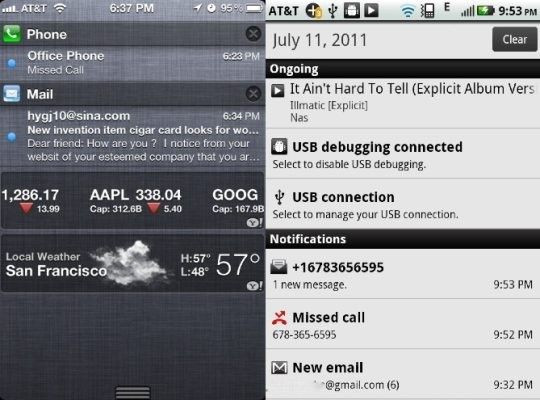iPhone 5 Features Taken From Android, Others

Anticipation is growing for Apple's next smartphone -- the iPhone 5 -- and while the company is as tight-lipped as ever, one needs only to look at rivals for hints of what might be included.
Hardware speculation aside, it's the software, iOS, that runs the phone and dictates the look, feel and character of the device, including its features.
But regarding the software, what's coming in the iPhone 5 is no secret. In fact, Apple demonstrated the new software, dubbed iOS 5, this past June at its Worldwide Developer Conference in San Francisco.
Boasting over 200 improvements, Apple execs raved about the great innovations coming to the next platform.
And while Apple does bring a lot to the table, some additions may not be so magical to those that have used rival platforms.
Let's look at the five key features and their origins.
Notifications
Of the 200 new features, perhaps the most important are the changes made to the phone's notification system -- or the way it lets you know that you have a missed call or new text-message.
The way Apple notifies users now is a throwback to its first iPhone in 2007. Pop-ups appear above running applications, forcing users to respond before they disappear, running the risk of interruption and annoyance.
But in iOS 5, Apple has taken a page from rival Google's Android operating system to make things more streamlined and easier to manage. Incoming notifications now give a subtle indication across the top of the screen without disturbing whatever it is the user is doing. The notifications are also aggregated and accessible by sliding your finger across the top.
After the user checks, instead of disappearing completely, notifications are now archived: iOS 5 also introduces something Apple calls Notification Center, a single place that combines all of your notifications
When users visit the Notification Center, they can also see updates on weather and stocks.
Within Notification Center, you can tap a notification to switch directly to the app that sent that notification, or you can easily delete notifications when you no longer need them. If you dismiss Notification Center, you get right back to your app.
Wireless Sync
Apple is catching up to rivals by cutting the iPhone's dependency on computers and allowing iOS devices to function fully independently.
New iPhones will lose the traditional Connect to iTunes screen upon first start-up and instead display a Welcome screen -- with a quick swipe, you can activate your device on the device itself.
New software can be downloaded over the air, bringing the iPhone in line with rivals like Research In Motion's BlackBerry. Android devices have also enjoyed this capability.
Other tasks that typically depended on a computer are also being consolidated within the device itself. Various tasks -- like adding and deleting calendars and mailboxes, and even basic photo editing -- will, in iOS 5, be possible right on the iPhone, iPad or iPod Touch with no computer.
iMessage
iMessage is one feature that users will love, but wireless carriers may disparage.
The new messaging feature lets users skirt wireless messaging fees to send texts, photos and videos to other contacts using iOS through the data feed for free.
Different from traditional text messaging, iMessage messages can be sent only between iOS devices, but the technology adds features like group-chat, delivery receipts, read receipts and iChat-like indications of when your contacts are typing back.
The new tool is similar to BlackBerry Messenger on RIM devices. Android devices have something similar called G-Talk. It's not 100 percent analogous to those technologies because it can be used on computers and other devices as well, but like iMessage, it will be pre-installed and will facilitate non-SMS chat among Android users.
Better Mail
Mail is one of the most-used apps across iOS devices, Apple says.
But Apple's own mail client has been sorely lagging behind almost all competitors in its current form.
In iOS 5, Mail finally gets rich text formatting (think bold, italics, underline), indentation options, support for prioritization and things many business users would come to expect from a smartphone.
Full-message searching will now come to iPhone and iPod Touch users, which Apple says will include messages not downloaded onto the device but present on the server. And on the iPad, you can now swipe to bring up the inbox when in portrait mode.
These features turn the iOS mail app more into a fully fledged mail-client that will be able to handle a lot more real work, letting Apple catch up to BlackBerry and Android.
The BlackBerry client has been the industry standard for quite some time, allowing mobile users to essentially mimic desktop behavior on the go. Android's client works similarly to Gmail. Both technologies integrate with each device, respectively, allowing custom notifications and the like.
The new iOS will finally do the same.
One function that Apple highlighted in the WWDC presentation is the new integration of Twitter through out the device.
New in iOS 5: single-sign-on support for Twitter. Once you configure your login credentials in the Settings app, third-party Twitter clients will be able to access your login details without requiring separate sign-in within each app.
This is a good addition for people who tweet, but it highlights some of the deficiencies in Apple's closed system.
On Blackberry, for instance, users can get this functionality simply by downloading the app itself, since RIM allows the app to make changes to native menus with your permission.
Hiowever, if you want to send a photo to Facebook, you would be out of luck.
© Copyright IBTimes 2024. All rights reserved.





















